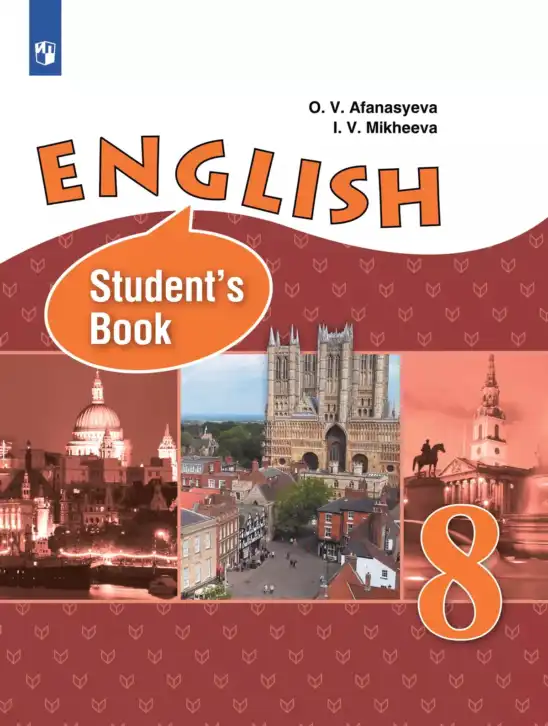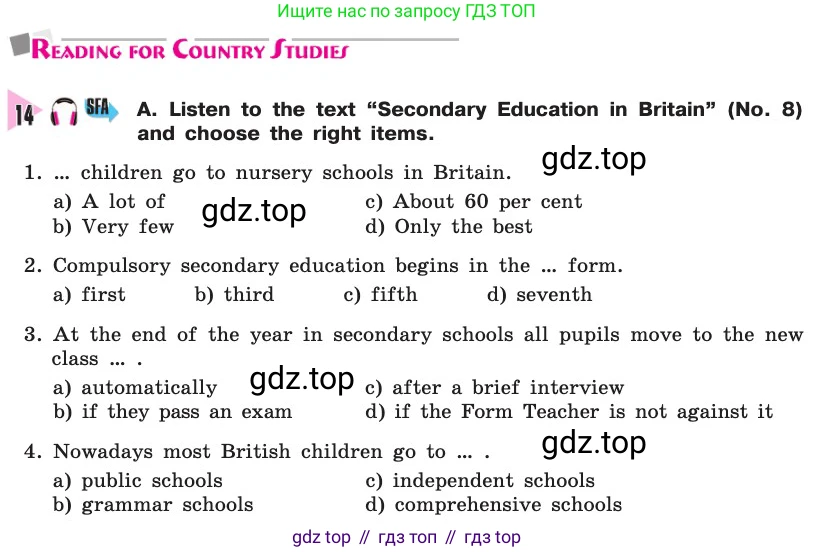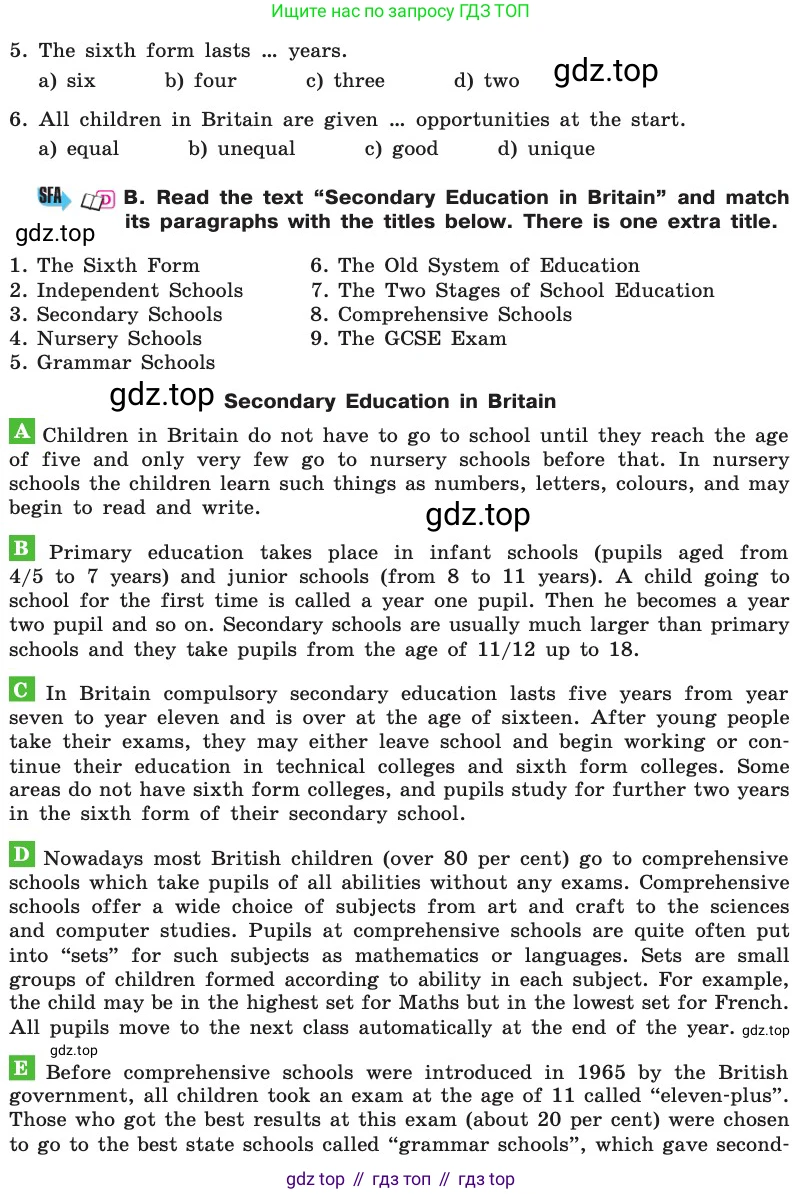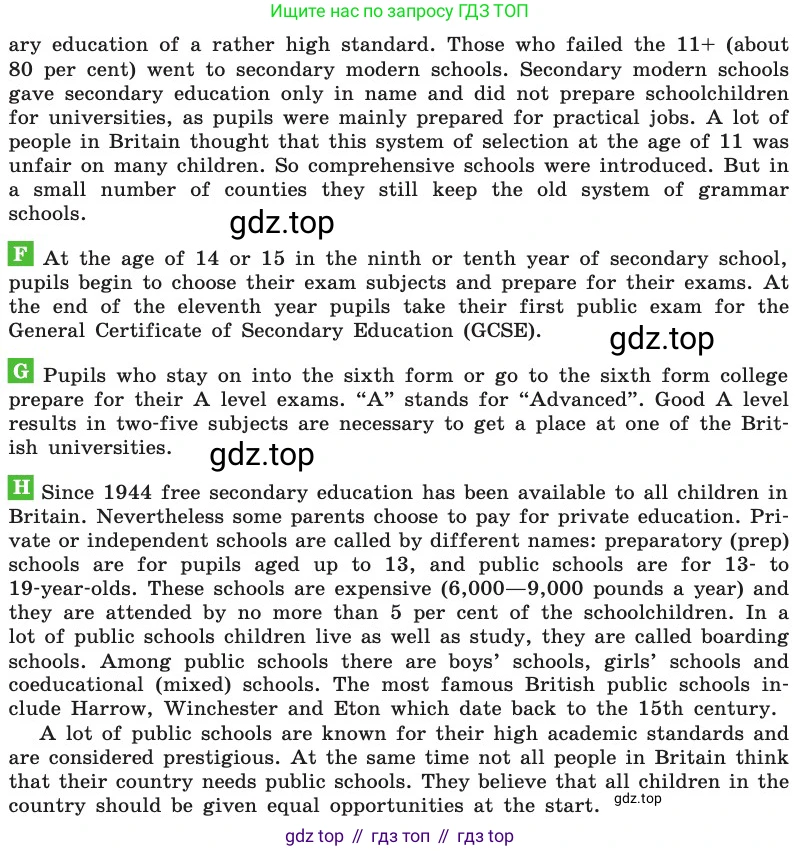Номер 14, страница 46 - гдз по английскому языку 8 класс учебник Афанасьева, Михеева

Авторы: Афанасьева О. В., Михеева И. В.
Тип: Учебник
Издательство: Просвещение
Год издания: 2014 - 2025
Уровень обучения: углублённый
Цвет обложки: белый
ISBN: 978-5-09-034201-8
Допущено Министерством просвещения Российской Федерации
Популярные ГДЗ в 8 классе
Unit 2. Education: The World of Learning. Reading for Country Studies: «Secondary Education in Britain» - номер 14, страница 46.
№14 (с. 46)
Условие. №14 (с. 46)
скриншот условия



READING FOR COUNTRY STUDIES
14 🎧 SFA A. Listen to the text "Secondary Education in Britain" (No. 8) and choose the right items.
1. ... children go to nursery schools in Britain.
a) A lot of c) About 60 per cent
b) Very few d) Only the best
2. Compulsory secondary education begins in the ... form.
a) first b) third c) fifth d) seventh
3. At the end of the year in secondary schools all pupils move to the new class ... .
a) automatically c) after a brief interview
b) if they pass an exam d) if the Form Teacher is not against it
4. Nowadays most British children go to ... .
a) public schools c) independent schools
b) grammar schools d) comprehensive schools
5. The sixth form lasts ... years.
a) six b) four c) three d) two
6. All children in Britain are given ... opportunities at the start.
a) equal b) unequal c) good d) unique
SFA 📖 B. Read the text "Secondary Education in Britain" and match its paragraphs with the titles below. There is one extra title.
| 1. The Sixth Form | 6. The Old System of Education |
| 2. Independent Schools | 7. The Two Stages of School Education |
| 3. Secondary Schools | 8. Comprehensive Schools |
| 4. Nursery Schools | 9. The GCSE Exam |
| 5. Grammar Schools |
Secondary Education in Britain
A Children in Britain do not have to go to school until they reach the age of five and only very few go to nursery schools before that. In nursery schools the children learn such things as numbers, letters, colours, and may begin to read and write.
B Primary education takes place in infant schools (pupils aged from 4/5 to 7 years) and junior schools (from 8 to 11 years). A child going to school for the first time is called a year one pupil. Then he becomes a year two pupil and so on. Secondary schools are usually much larger than primary schools and they take pupils from the age of 11/12 up to 18.
C In Britain compulsory secondary education lasts five years from year seven to year eleven and is over at the age of sixteen. After young people may either leave school and begin working or continue their education in technical colleges and sixth form colleges. Some areas do not have sixth form colleges, and pupils study for further two years in the sixth form of their secondary school.
D Nowadays most British children (over 80 per cent) go to comprehensive schools which take pupils of all abilities without any exams. Comprehensive schools offer a wide choice of subjects from art and craft to the sciences and computer studies. Pupils at comprehensive schools are quite often put into "sets" for such subjects as mathematics or languages. Sets are small groups of children formed according to ability in each subject. For example, the child may be in the highest set for Maths but in the lowest set for French. All pupils move to the next class automatically at the end of the year.
E Before comprehensive schools were introduced in 1965 by the British government, all children took an exam at the age of 11 called "eleven-plus". Those who got the best results at this exam (about 20 per cent) were chosen to go to the best state schools called "grammar schools", which gave secondary education of a rather high standard. Those who failed the 11+ (about 80 per cent) went to secondary modern schools. Secondary modern schools gave secondary education only in name and did not prepare schoolchildren for universities, as pupils were mainly prepared for practical jobs. A lot of people in Britain thought that this system of selection at the age of 11 was unfair on many children. So comprehensive schools were introduced. But in a small number of counties they still keep the old system of grammar schools.
F At the age of 14 or 15 in the ninth or tenth year of secondary school, pupils begin to choose their exam subjects and prepare for their exams. At the end of the eleventh year pupils take their first public exam for the General Certificate of Secondary Education (GCSE).
G Pupils who stay on into the sixth form or go to the sixth form college prepare for their A level exams. "A" stands for "Advanced". Good A level results in two-five subjects are necessary to get a place at one of the British universities.
H Since 1944 free secondary education has been available to all children in Britain. Nevertheless some parents choose to pay for private education. Private or independent schools are called by different names: preparatory (prep) schools are for pupils aged up to 13, and public schools are for 13- to 19-year-olds. These schools are expensive (6,000–9,000 pounds a year) and they are attended by no more than 5 per cent of the schoolchildren. In a lot of public schools children live as well as study, they are called boarding schools. Among public schools there are boys' schools, girls' schools and coeducational (mixed) schools. The most famous British public schools include Harrow, Winchester and Eton which date back to the 15th century. A lot of public schools are known for their high academic standards and are considered prestigious. At the same time not all people in Britain think that their country needs public schools. They believe that all children in the country should be given equal opportunities at the start.
Решение. №14 (с. 46)


Другие задания:
Помогло решение? Оставьте отзыв в комментариях ниже.
Присоединяйтесь к Телеграм-группе @top_gdz
ПрисоединитьсяМы подготовили для вас ответ c подробным объяснением домашего задания по английскому языку за 8 класс, для упражнения номер 14 расположенного на странице 46 к учебнику 2014 года издания для учащихся школ и гимназий.
Теперь на нашем сайте ГДЗ.ТОП вы всегда легко и бесплатно найдёте условие с правильным ответом на вопрос «Как решить ДЗ» и «Как сделать» задание по английскому языку к упражнению №14 (с. 46), авторов: Афанасьева (Ольга Васильевна), Михеева (Ирина Владимировна), углублённый уровень обучения учебного пособия издательства Просвещение.
















